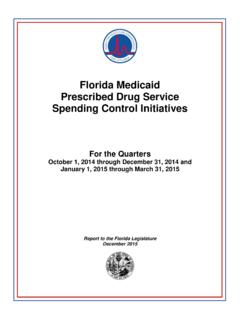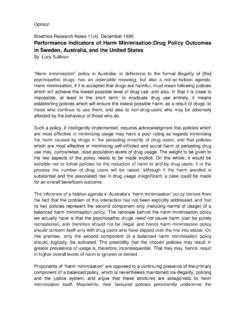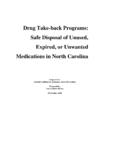Transcription of Prevention of drug use and treatment of drug use …
1 Prevention OF drug . USE AND treatment . OF drug USE disorders . IN RURAL SETTINGS. REVISED VERSION. SPECIAL POPULATIONS SERIES. united nations office ON DRUGS AND crime . Vienna Prevention OF drug USE AND. treatment OF drug USE disorders . IN RURAL SETTINGS. REVISED VERSION. united nations . New York, 2017. united nations , March 2017. All rights reserved, worldwide. The designations employed and the presentation of material in this publication do not imply the expression of any opinion whatsoever on the part of the Secretariat of the united nations concerning the legal status of any country, territory, city or area, or of its authorities, or concerning the delimitation of its frontiers or boundaries. Information on uniform resource locators and links to Internet sites contained in the present publication are provided for the convenience of the reader and are correct at the time of issue. The united nations takes no responsibility for the continued accuracy of that information or for the content of any external website.
2 This publication has not been formally edited. Publishing production: English, Publishing and Library Section, united nations office at Vienna. Acknowledgements This Guide on Prevention of drug Use and treatment of drug Use Disorder in Rural Settings was prepared by the united nations office on Drugs and crime (UNODC) drug Prevention and Health Branch (DHB), in the context of the global project Treatnet II: OFID-UNODC Programme to prevent HIV/AIDS through Treatnet Phase II, with the aim of providing an awareness-raising tool and guidance for policymakers, public health offi- cials, local authorities and other stakeholders in dealing with substance use issues in rural settings in their respec- tive countries. UNODC would like to acknowledge the following persons for their important contributions to the process of publishing this document: The Expert Group, consisting of Reychad Abdool, Murat Alkan, Holly Andrilla, Oscar Arteaga, Muhammad Ayub, Susmita Banerjee, Jan Bashford, Tay Bian How, Jerry Case, Mari ngels Duch, Nabila E l-Bassel, Kathy Etz, Sean Fearns, Nan Fife, Alexandrina Grigoryeva, Rob van der Hazel, Furkan G rb z, Dijana Jerkovi , Pamela Kaduri, Ziad Khatib, Tam s Ko s, Alexander Kozlov, William McGlynn, Juliana Mej a, Shannon M.
3 Monnat, Dennis O'Reilly, Augusto P rez-G mez, Tuuli Pitk nen, Nancy Roget, Darko Rovis, Fraidoon S adeed, Eduard Sagan, Eric Siervo, William Sinkele, J n Sigf sson, Richard Spoth, Sarah Swatzburg, Tanya Tatum, Judith Twala and Thirumagal Veeraraghavan for their invaluable guidance and input to this document. Nicolas Clark, Medical Officer, Management of Substance Abuse Unit, WHO. John Gale, UNODC consultant, for the development of this document. Gilberto Gerra, UNODC/DHB, who coordinated the overall effort, and additional staff of UNODC/DHB, for their commitment and substantive contributions that helped bring this document to life (in alphabetical order): Anja Busse, Giovanna Campello, Christina Gamboa-Riano, Hanna Heikkila, Giulia Milano, Elizabeth Mattfeld, Wadih Maalouf, Olga Parakkal, Elizabeth Saenz and Sanita Suhartono. UNODC staff in the field offices and experts globally for providing substantive support. The Bureau of International Narcotics and Law Enforcement Affairs (INL), united States Department of State, for the technical and financial support of this endeavour.
4 Iii CONTENTS. 1. INTRODUCTION 1. Background 2. Purpose of this Guide 5. Intended audience 6. How to use this Guide 6. 2. THE CONTEXT OF RURAL PLACE 7. Defining rurality 8. Global changes in rural population areas 10. Isolation, travel and distance barriers 12. Indigenous populations 12. Rurality as a driver of substance use disorders 13. Conclusion 21. 3. SYSTEM ASSESSMENT AND PLANNING 23. Policy framework 24. Planning for a rapid assessment and response 26. Global aspects with regard to the development of a multi-level system assessment process 29. System-level assessment: policy assessment and context at national and provincial levels 29. Local context for the development of rural Prevention , treatment and recovery strategies for addressing drug and substance use 33. Assessment framework, and monitoring and evaluation 34. Conclusion 36. 4. EVIDENCE-BASED drug Prevention STRATEGIES FOR RURAL SETTINGS 39. Introduction 40. Focusing on the community 42.
5 Factors influencing substance use: the ecological model 44. Good practices and a process for planning, implementing and sustaining community-based Prevention in rural settings 46. Good practices for addressing barriers to implementing Prevention in rural settings 59. Conclusion 63. iv 5. EVIDENCE-BASED drug treatment STRATEGIES FOR RURAL SETTINGS 65. Introduction 66. Challenges to developing comprehensive rural s ubstance use treatment services 66. Developing substance use treatment services in rural areas 68. The components of a comprehensive substance use treatment system of care 68. Understanding substance use and addiction 72. Developing rural community-based systems of substance use treatment and care 73. Addressing resource constraints in rural community-based systems of substance use treatment and care 75. Developing a continuum of substance use services in a rural community-based system of care 79. Expanding access to substance use t reatment services by enhancing p rimary care capacity 80.
6 Specific treatment issues and populations 81. The use of t echnology, lay health care professionals and itinerant teams to expand access to . substance use treatment services in rural settings 84. Medication-assisted treatment for opioid use disorders 87. Conclusion 88. 6. RECOVERY AND PEER SUPPORT PROGRAMMES 89. The importance of recovery and peer support programmes in substance use disorder treatment 90. What is recovery? 91. Integrating recovery into treatment 92. Conceptual framework for a recovery-oriented s ystem of care 92. Conceptual framework of recovery management 95. The difference between recovery-oriented systems of care and recovery management 95. Implementing recovery-oriented systems of care at the national level 96. Implementing recovery management in rural areas 97. Using technology to support recovery 101. Addressing the social determinants of health 102. Conclusion 104. 7. FINAL CONCLUSION 105. ANNEXES 107. Annex A 108.
7 Annex B 110. v 1. INTRODUCTION. 2 Prevention OF drug USE AND treatment OF drug USE disorders IN RURAL SETTINGS. Background global drug use among people in treatment by geographic region. drug use1 has traditionally been viewed as an urban and inner city problem. However, with the past The united nations office on Drugs and crime decade's increase in prevalence of substance use (UNODC) estimated that more than 247 million disorders and substance-related mortality in rural people between the ages of 15 and 64 used at least one areas, there is growing international recognition that drug in This represents an increase of 39 mil- the problem of drug and other substance use has lion users since 2006. Of this group, approximately spread to rural settings across the globe. This is true 29 million people (12 per cent) have a drug use disor- for both developing and industrialized countries. The der. In 2016, 183 million people had used cannabis, use of opioids (including heroin and the non-medical 34 million had used amphetamines and 33 million use of prescription medications), methamphetamine, had used opioids.
8 Roughly half of all opioid users used cocaine, cannabis and other substances is growing. heroin or opium, and the remaining half used diverted Figure provides an overview of the trends in prescription FIGURE PRIMARY drug USE AMONG PEOPLE IN treatment , BY REGION, 2003, 2009 AND 2014. 100. 90. 80. Proportion of people in drug treatment 70. 60. 50. (percentage). 40. 30. 20. 10. 0. 2003. 2009. 2014. 2003. 2009. 2014. 2003. 2009. 2014. 2003. 2009. 2014. 2003. 2009. 2014. 2003. 2009. 2014. 2003. 2009. 2014. Africa North Latin America Asia Eastern and Western and Oceania America and the South-Eastern Central Europe Caribbean Europe Cannabis Opioids Cocaine Amphetamine-type stimulants Other drugs Source: UNODC, World drug Report 2016, page 9. 1 Throughout this document the term drug use is used to refer to the non-medical use of substances controlled under the international conventions, while substance use is used to refer to the use of any psychoactive substances regardless of their control status.
9 2 united nations office on Drugs and crime , World drug Report 2016. Vienna: united nations office on Drugs and crime . (Sales No. ). 3 united nations office on Drugs and crime , World drug Report 2013. Vienna: united nations office on Drugs and crime . CHAPTER 1. introduction 3. Although data on the prevalence of rural drug use driven primarily by the limited alternative opportu- are not available for many countries, existing nities in depressed rural Older studies evidence suggests differing patterns of use. For have suggested that, despite the greater prevalence of example, evidence from the united States suggests drug use in urban settings, government officials in that the rates of drug use across urban and rural set- Chile, Ecuador and Mexico recognized the emer- tings are very similar. In contrast, evidence from gence of frontier patterns of use and that rural use is countries such as Afghanistan reflects the growing associated with traditional consumption (opium in nature of drug use in rural areas of developing Asia, coca leaves in Latin America).
10 6 Given the evi- countries, where drug use is greater in rural settings dence, it is reasonable to assume that rural settings than in urban The evidence from South are being equally damaged, if not more severely, by America regarding rural and urban drug use is less this growing global trend. The differing evidence clear. Some studies have documented the growth of across disparate countries also highlights the need drug trafficking and related problems in rural for policymakers to undertake studies to quantify Colombia, Mexico and other countries as being the prevalence of substance use in rural settings. FIGURE NUMBER OF PEOPLE WITH drug USE disorders RECEIVING treatment WORLDWIDE. 247 MILLION PEOPLE USED DRUGS IN THE PAST YEAR. 29 MILLION SUFFER FROM drug USE disorders . BUT ONLY 1 IN 6 PEOPLE WITH drug USE disorders IS IN treatment . Source: UNODC, World drug Report 2016, page 9. Available: 4 Simon, M. The drug Trade in Afghanistan: Understanding Motives Behind Farmers' Decisions to Cultivate Opium , Foreign Policy Journal, 2015, November 15: 1-13.














